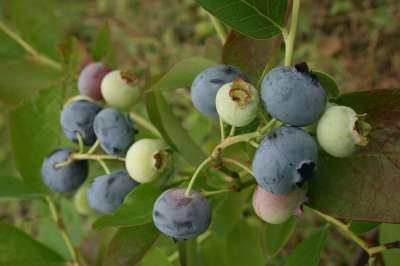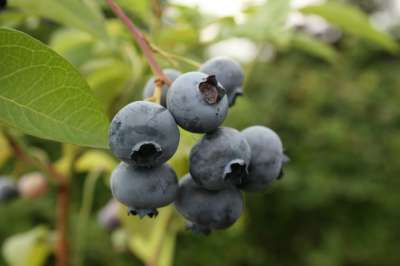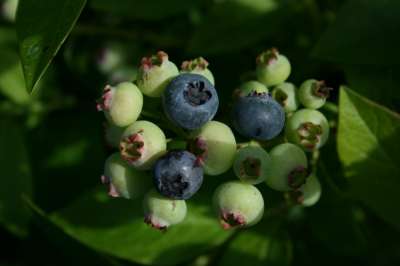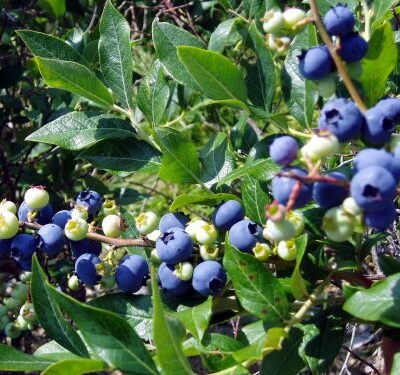Your basket is currently empty!
How to plant a Blueberry Bush
Blueberry plants available here
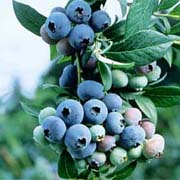
First prepare the soil as described, incorporating generous quantities of peat and first ensuring that is has the correct ph. The soil should be nicely friable and the site fairly sunny for preference and not too dry. As these subjects are fairly slow growing make sure they won’t receive too much competition from neighbouring subjects. Space bushes 6’ apart in rows, less for compact varieties such as Top Hat or Sunshine Blue.Your Blueberry will almost always be supplied in a pot to start with. They don’t appreciate root disturbance and don’t do well lifted and supplied from the open ground and this is why nurseries almost always grow them in containers. This makes them easy to plant. Once the soil is prepared, simply dig a hole large enough to take the root ball and set it so that it sits just level with the soil surface when planted. Firm well and water in heavily.You can Blueberries at any time of year, including the winter as long as the soil is workable. At this time I would recommend watering in just to settle to soil but further irrigation should then not be required.
When to transplant Blueberry bushes
Blueberries are often planted during the Spring and Summer months. They establish well set at this time of year, but due care and attention should be given to regular watering for a few weeks after the new Blueberry bushes have been planted. A heavy ‘puddling’ with a hose is almost essential, evening and early am, for the first 2 weeks. Thereafter once a day should suffice until the bushes are completely established. Staking is not necessary but rabbits are quite partial to the new shoots so if you have rabbits in the vicinity be prepared to offer some protection.Sulphate of ammonia is a good general purpose feed for Blueberries grown in the open ground, apply at 1oz per square yard in early Spring and rake it into the soil immediately surrounding the bush. Growmore can also be applied during the winter.A mulch is very beneficial to Blueberries as it conserves moisture, ensuring extra-plump berries and maki ng sure the bushes don’t become too stressed. Peat, leafmould or sawdust are all excellent materials to use, spread it about 2” deep around the base of the bushes. Such a practice also suppresses weed growth. Pine needles or bark chippings are also a very good medium to spread around Blueberries.It is important to remember that no form of animal manure or organic animal matter is acceptable to Blueberries as it often causes the roots to scorch and can result in death of the plant.
Planting Blueberries in containers – the best Blueberry bush compost
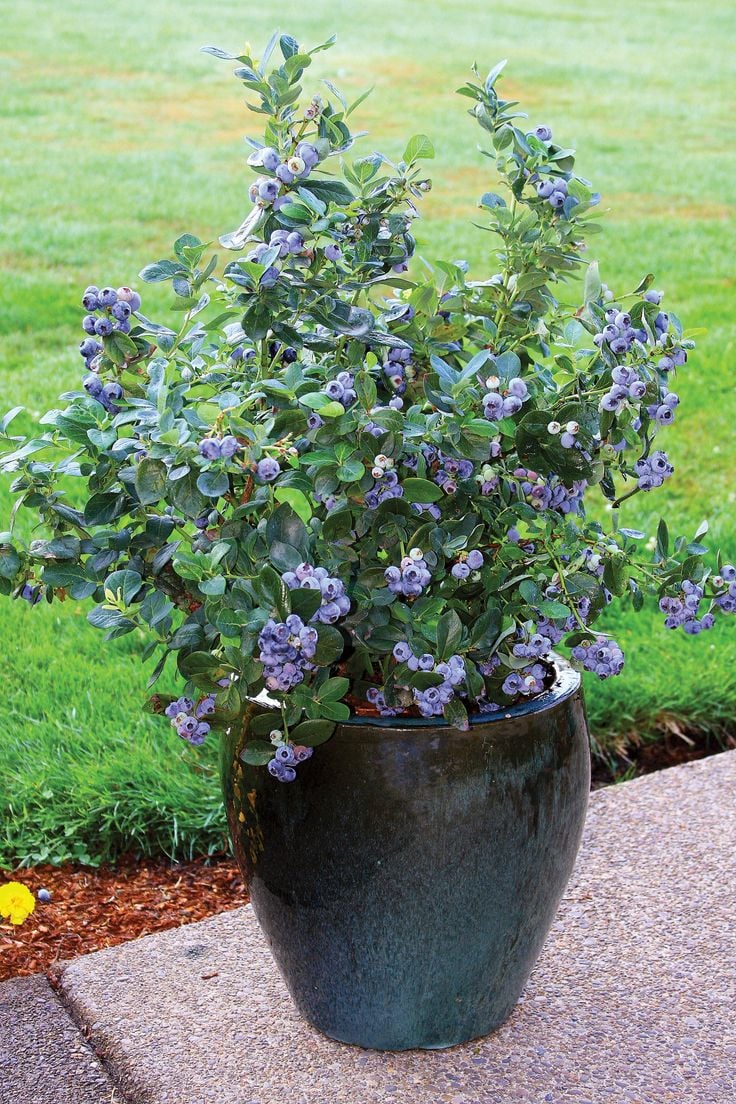
This is quite a simple procedure and all varieties are equally suited to container growing. An enormously large container is not required because Blueberries have surprisingly small roots and they are very fibrous. There are no tap roots. Therefore a container size of not less than 15” is required for the first 2 or 3 years, thereafter they can be moved up to a 20 or 24” container. I do not advise ‘over potting’ from the early stages because all that will happen is the bottom third of the pot will remain unused, the compost will go stale and airless and the poor plant will sit in a compacted ‘pan’ of compost.The compost we use for Blueberry bushes is always a proprietary ericaceous compost for reliable results. This will already have the correct ph and enough nutrients for the first few weeks of active growth. Any compost sold as suitable for rhododendrons and azaleas is very suitable as these plants enjoy the same conditions as Blueberry bushes.
After that be prepared to offer additional feeding with sequestrine or a small amount of eriaceous fertilizer such as Miracle Grow ericaceous. It is important not to over-do the feeding for Blueberries grown in pots as their requirements are fairly low but make sure it is done in small quantities once or twice a year.Although the Blueberry is essentially very hardy, specimens grown in containers can sometimes be subject to damage in very cold winters as they are more exposed than plants grown in the ground. So be prepared to wrap the container in horticultural fleece if conditions get too severe.When you have set your Blueberry in it’s new home make sure it is at the same level as it was previously, not any deeper. And of course water it in well. Long-term, watering is one of the most important aspects necessary to ensure it’s continued wellbeing. These are plants that never like to be dry at the roots. You can sit the pot[s] in a shallow tray of water to facilitate convenient watering, it is easier to water from the bottom and simply remember to fill the tray up once each day, or every other day as the nights draw colder. Watering during the winter is seldom required.After 4 or 5 years it is best to re-pot your Bluebrrries. It should not be necessary by now to increase the container size, but you can tease out some roots and remove some of the loose compost to make some room and then re-set in the same container with some fresh compost. If the root ball has become quite congested you can ‘shave’ some off with a sharp knife to reduce it a bit.One creepy crawly that is especially troublesome to Blueberries is the Vine Weevil and this seems to be especially true with plants grown in pots. Keep an eye out and if necessary apply one of the many treatments available on the market.
Pruning Blueberry Bushes
If you do not prune at all it won’t be too much of a disaster. These aren’t subjects that require a strict pruning regime to give of their best and in this respect they are almost unique in the fruit world. But young specimens can sometimes be reluctant to branch well and in this situation the main stems can be reduced by a third to encourage branching.Established bushes can benefit from shortening of some older fruit-bearing branches. They can be shortened to a vigorously growing shoot so as to encourage good new fruit bearing growth. Any damaged or dead branches should be removed completely at the base. Pruning is best carried out during the winter time.
Chlorosis
If you bushes turn an ugly pale colour then it is as a good indicator that the soil ph isn’t right. You can redress this with a good mulch of plain peat and by feeding with sequestrine.
Feeding Blueberry Bushes
Both young vigorously growing bushes, and established older ones that have maybe lost their impetus, benefit from a good feed on a regular basis. It’s important to remember their acid-loving tendencies when selecting the right food for them. For the best results we recommend sequestrine of Miracle Grows special Camellia, Azalea and Rhododendron feed – it works a treat for Blueberries as well; apply as per the manufacturers instructions, during the growing season, or at the start of the growing season.
Protection from birds
Our feathered friends are quite partial to Blueberries alas so some protection is necessary unless you live in a very urban area where it is likely to be less of a problem.Bushes grown in the open ground should be netted just as the first berries are beginning to turn colour. The same applies to those grown in containers, although where these are placed close to the house on the patio the fruits might escape predation. Make sure there aren’t even any small gaps in the netting as otherwise the birds’ will find it. You might want to build a basic mesh covered wooden frame to place over your bushes, this can be brought out and re-used every year, and allows the berries to keep on ripening whilst also allowing easy access for harvesting. Blackbirds and thrushes [much as we love them so] are the worst culprits followed by pigeons. Smaller birds are not so much of a problem with blueberry predation.If you have a fruit cage then the Blueberry would be one of the first choices to allocate valuable space within it.
Harvesting the fruits
Don’t pick your Blueberries too soon! They are aren’t really ripe for a week after turning blue, they should start to soften a little but still have a good waxy bloom. As the berries won’t ripen all at once it should be necessary to go over the bushes 3 times to catch all the berries at the optimum stage of ripeness. The fruits of the blueberry aren’t particularly delicate, infact commercial harvesting takes place with a machine that shakes the bushes so vigorously the fruits drop onto the floor, caught with a sheet! That’s fine if you have a lot of bushes heavily laden with fruits but for the home gardener I think picking them by hand is more appropriate! It is important to ‘know’ when the berries are properly ripe because picked too soon the flavour and juice levels won’t have developed properly and the fruits may be tart.Once harvested the fruit can be kept in a ‘fridge’ for up to 2 weeks if required. They also freeze well and are suitable for all purposes, be it dessert use, jams, pies or juicing.
Pests and diseases
Few of our fruiting plants are troubled less with pestilence than the Blueberry. Infact that aren’t really any prevalent fungal diseases you need to know about.The bushes can be targeted by vine weevils, especially those grown in pots so be vigilant against those insects. And as mentioned before, Blueberries are partial to the leaves and stems so protection should be sought if you have bunnies in your garden.
The Blueberry season
So, when exactly can you expect to be harvesting your delicious Blueberries? In the UK the season normally starts in the second half of July and continues through most of August. This is dependent on local growing conditions, prevailing weather paterns and locality. But it’s a good estimate. With careful selection you can have fresh blueberries for a good six weeks. That’s why, if you are serious about growing Blueberries, it is wise to select a few different varieties so that they cover the season. Here is a list of fairly commonly available varieties, listed in order of ripening. By selecting varieties spread throughout the list you will gain the very longest ripening period for these delicious fruits.EarlyPatriotBluettaGroverWeymouthNorthlandMidBluecropBlue RayBerkleyCovilleCollinsIvanhoeHerbertHeermaLateJerseyGoldtraubeLateblue
Variety Recommendations
Most, if not all of the varieties grown in the UK have already been tried and tested and should provide quality results. But, asked to choose we would always recommend these as being particularly hardy and reliable.As a good mainstay of any planting programme – Bluecrop and Berkley Blueberry Bushes.For vigour, durability and prolific yield – Northland Blueberry BushesFor delectable flavour – Herbert Blueberry Bushes and Sunshine Blue.For late season fruits:Goldtraube Blueberry Bushes.
Yield expectancy for Blueberries
It takes a while for a blueberry to reach optimum cropping capacity – between 5 and 10 years. But don’t despair, even young bushes start to crop more or less straight away and yields should increase gradually with every year. When at it’s peak a commercial Blueberry will give up to 6ibs of fruit. That’s a lot of Blueberries! Of course regular feeding and a good cultivation regime will result in optimum cropping capacity.Blueberries can be planted together with…..Why not ring the changes by planting in combination with Cranberries and Lingonberries. These closely-related fruits enjoy exactly the same soil conditions. What’s more they are evergreen and shorter in growth. You could plant them at the base of the Blueberries and allow them to carpet the ground beneath. The cranberry no doubt you are familiar with but Lingonberries – maybe not. Think of them as a type of North European cranberry and you won’t go far wrong. The brilliant, gleaming red fruits ripen late and are highly esteemed and popular for juice making in Scandinavia [you can buy the juice in health food shops here as it’s very high in vitamins and antixodiants] Both the Cranberry and Lingonberry are quite attractive shrublets, the Lingonberry especially so with its oval polished leaves and clusters of urn shaped flowers.The Blueberry is just made for todays moderns gardens, with it’s slow growing but precocious nature, beautiful good looks and hardiness it makes sense to incorporate them into your garden or patio. The fruits themselves are so often being promoted as the good-for-you food and certainly they are high in vitamins, but with the sky-high price of them in the shops, most of us can only afford them as a treat. With a Blueberry bush yielding for 15-20 years, it makes sense to make room for some bushes in your own garden.



